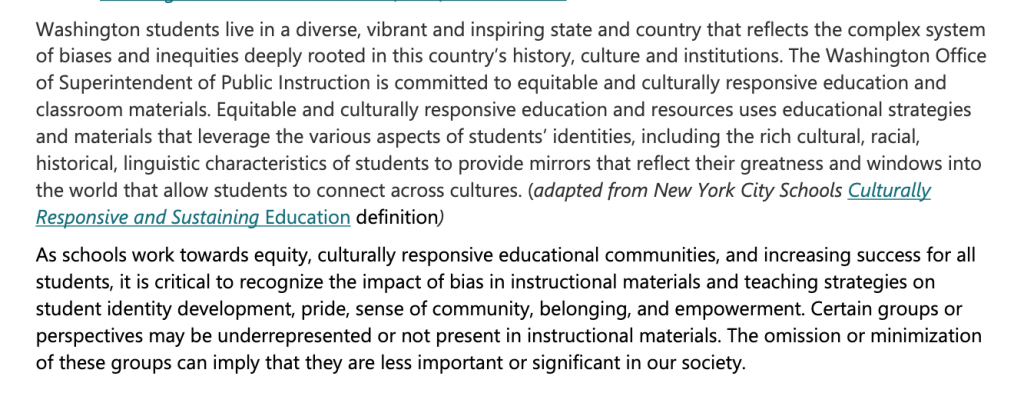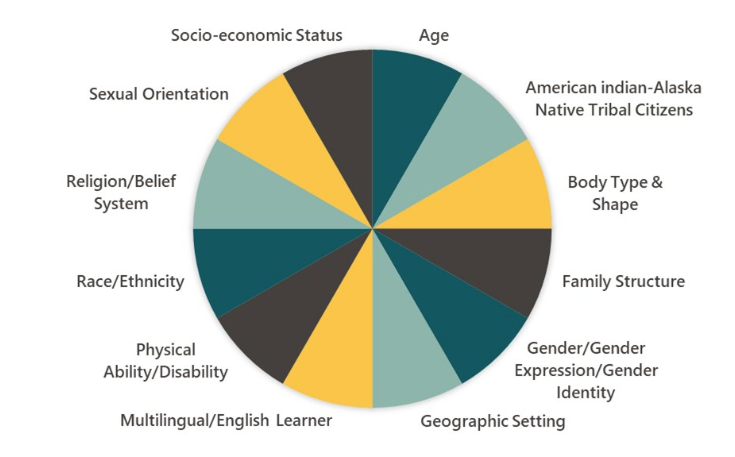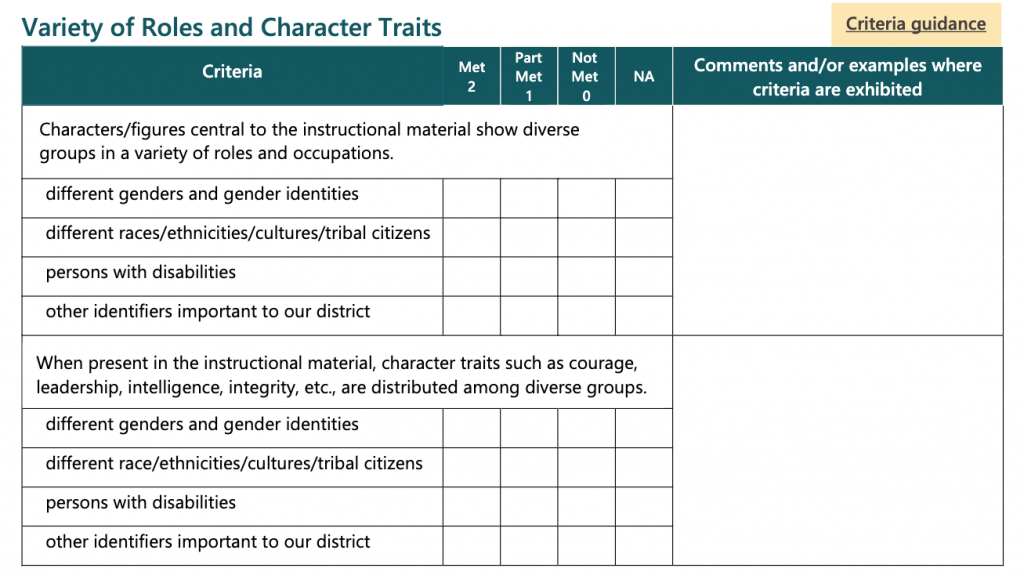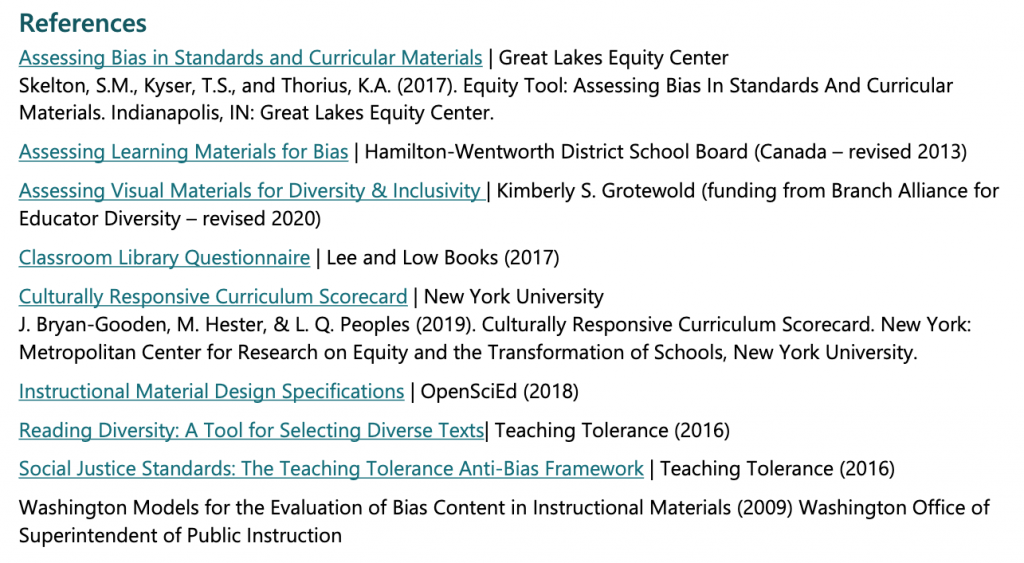An Inside Look At How Public Schools Are Scrubbing Materials To Remove Old Ideology And Promote Social Justice
Its Screening for Biased Content in Instructional Materials guide to help educators across the state first identify and then eliminate any bias seen in instructional materials being used throughout the state. The “model screening tool” is claimed to have been developed so school districts can better comply with the Washington State nondiscrimination law.
The Washington Office of Superintendent of Public Instruction (OSPI) has presented its Screening for Biased Content in Instructional Materials guide to help educators across the state first identify and then eliminate any bias seen in instructional materials being used throughout the state. The “model screening tool” is claimed to have been developed so school districts can better comply with the Washington State nondiscrimination law.
OSPI looked at the New York City Schools Culturally Responsive and Sustaining Education guide to cultivate how and why they intend to go through every piece of material in hopes to remove all perceived bias. They say:
“Washington students live in a diverse, vibrant and inspiring state and country that reflects the complex system of biases and inequities deeply rooted in this country’s history, culture and institutions. The Washington Office of Superintendent of Public Instruction is committed to equitable and culturally responsive education and classroom materials. Equitable and culturally responsive education and resources uses educational strategies and materials that leverage the various aspects of students’ identities, including the rich cultural, racial, historical, linguistic characteristics of students to provide mirrors that reflect their greatness and windows into the world that allow students to connect across cultures.“
They believe screening for educational bias is one big step towards making schools much more relatable for every student, regardless of race, gender, sexual orientation, and gender identity. OSPI claims that certain groups or their perspectives may be underrepresented in the material or not even at all. They believe these omissions carry the implication that they are less important than others within our society.

Opponents of the move say that instead of removing bias, these reviewers are actually selectively removing materials which might challenge their own bias. It’s part of what critics are lumping in under the heading of Critical Race Theory, a move towards educating students to believe in controversial views about race. For people critical of this ideology, the new screening plans harken back to the ideas of George Orwell’s 1984, in which the lead character is tasked with scrubbing documents to remove references which might challenge orthodox ideology. But for those in favor of it, they only see what they’re doing as the best way to challenge racism.
The education bias screening tool is designed to take a close look at all instructional material within all Washington State School Districts that is planned for adoption, but they also have a bigger goal in mind. The hope is that this screening tool can be used in communities whose efforts focus on “anti-racism, equity, culturally responsive teaching practices, and inclusion.” Those words in quotes are usually buzz words strongly associated with the Critical Race Theory movement and the widely challenged 1619 Project.
Washington state laws, as with all states, outline their basic education goals as well as minimal instructional requirements all school districts are to follow. School districts are required to have their policies and procedures set so they can guide districts as to how they are to select and adopt instructional materials for classroom use. They also have a system in place where complaints can be filed concerning certain materials used by school districts.
This new screening tool is an extension of the state’s 2009 model. They have expanded on how to look for what they believe to be bias while also expanding who the bias is directed at. Things have changed in public schools immensely since 2009. The new guide offers a complete breakdown of how review teams are expected to search for education bias.
What’s Actually In Washington’s Bias Plan
In the guide, one of the first items stressed is that it is imperative that members of the review teams are able to look at the educational material “through different lenses.” Their own personal biases and experiences may interfere with the intended goal. What one person considers to be biased may not be considered by another. What they don’t establish is that the review teams will be composed of people with varying views. Probably because they won’t.
Once review teams understand how to tackle the materials review, they then need to understand how they are to score the material in question. The guide gives scoring instructions as well as assigned points and definitions. These range from Met (2), Partially Met (1), Not Met (0), and Not Applicable. Reviewers will be asked in the guide to score the instructional material based on these guidelines and when applicable, to include a rationale for each response.

After the evaluation process of the material, the review team will then have to interpret the results. If any areas are marked with a 0 or a 1, further discussion is required. This is where a reviewer’s “lens” comes into play. Were team members coming up with the same response? If they didn’t, why not? Did this discussion bring up more questions?

Included in the guide to identify and remove education bias is the scoring sheet. It is titled: Screening Tool for Biased Content. Under this are a number of different sections that cover items such as Variety of Roles and Character Traits, Multiple Perspectives and Contributions, Multicultural Representation, Imagery and Language, Family Representation, Teacher Guidance, Additional Considerations, and Final Recommendations.
There is also a breakdown of each of the above categories and how to approach them. It is a complete guide with one sole purpose – eliminate what proponents believes any education bias, as viewed through an activist, social justice lens.
Below is an excerpt detailing some of the resources developed to create Washington’s new guide…

Washington Leads The Fight Towards Anti-Racist Education?
Although it would appear that Washington state is taking the lead in this fight, as quoted earlier, “Washington students live in a diverse, vibrant and inspiring state and country that reflects the complex system of biases and inequities deeply rooted in this country’s history, culture and institutions,” the truth of the matter is that the attempted elimination of bias in instructional material has been ongoing for some time now. New York City’s Department of Education has already stated their Culturally Responsive-Sustaining Education (a term now being used to replace the term Critical Race Theory) effort and other states like Michigan, California, and Wisconsin have also taken up the task.
Going through each and every piece of instruction material will be a time-consuming effort, but one that many states are eager to accomplish. Whether it’s actually something they should be doing, remains a subject of heavy debate and scrutiny. Objections from parents and other critics, however, won’t stop Washington from moving full steam ahead. For some parents, that’s great news. For others, it’s cause to move to Texas.
You can read the entire, official, Screening for Biased Content in Instructional Materials guide below…



